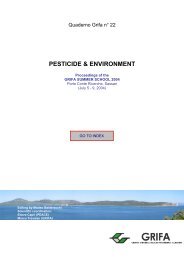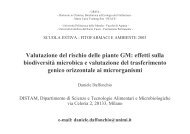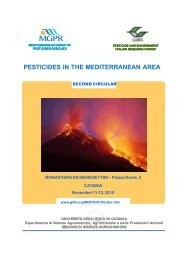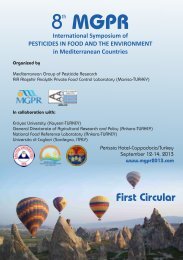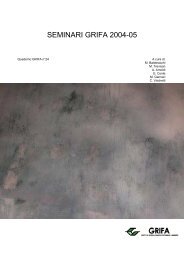International Congress BIOLOGICAL PRODUCTS - Gruppo di ...
International Congress BIOLOGICAL PRODUCTS - Gruppo di ...
International Congress BIOLOGICAL PRODUCTS - Gruppo di ...
Create successful ePaper yourself
Turn your PDF publications into a flip-book with our unique Google optimized e-Paper software.
35<br />
FUNGICIDES AND HEAVY METALS IN WINE SAMPLES PRODUCED FROM EXPERIMENTAL<br />
GRAPES SUBJECTED TO DIFFERENT PESTICIDES TREATMENTS<br />
Salvo Francesco, Saitta Marcello, Di Bella Giuseppa, La Pera Lara, Dugo Giacomo<br />
Dipartimento <strong>di</strong> Chmica Organica e Biologica Università <strong>di</strong> Messina Salita Sperone, 3190166 S. Agata -Messina<br />
Wine is a wildely consumed beverage with thousand years tra<strong>di</strong>tions, so an accurate quantitative knowledge of<br />
the presence of toxic elements as pesticides and heavy metals, is very important from both toxicological and enological<br />
point of view. The use of pesticides is closely associated with viticulture (1). Many factors influence the presence of<br />
heavy metals in wine: type of soil, wine-processing equipment, vinification methods (2). The purposes of this work are<br />
both to quantify pesticides residues and trace metals in samples of Italian wines, and to study the possible correlation<br />
between the presence these contaminants (3).<br />
Wine farms that comply with the Rule Cee 2078/92 for wine grape defense, have to respect all the provided<br />
restrictions regar<strong>di</strong>ng to the use of pesticides.<br />
To control the growth of powdery mildew (Uncinula necator), the use of sulfur, azoxystrobin, <strong>di</strong>nocap,<br />
fenarimol, penconazole, quinoxyfen, is allowed. Mildew epidemic weakens the vines, causing huge production losses<br />
and negatively influencing the quality of wines. Also an incorrect use of fungicide and frequency of their applications,<br />
maight alter the quality of the final product.<br />
The determination of fungicide residues in wine is well documented, even if the reported extraction procedures<br />
are complex and expensive; meanwhile there is a lack of available data regar<strong>di</strong>ng to the extraction of <strong>di</strong>nocap residue.<br />
In this work a quick chromatographic method for the simultaneous extraction of azoxystrobin, <strong>di</strong>nocap, fenarimol,<br />
penconazole, quinoxyfen residues in wine samples is described (4).<br />
The same samples of wine were subjected to trace metal determination as Cd (II), Cu (II), Pb (II) and Zn (II).<br />
Heavy metals dosage was carried out by derivative potentiometric stripping analysis (3), which allowed to execute the<br />
determinations in a short time <strong>di</strong>rectly on the wine sample appropriately aci<strong>di</strong>fied. The presence of Cd (II), Cu (II), Pb<br />
(II) and Zn (II) in white and red wine sample, was correlated to the treatments applied on grapes.<br />
Samples description<br />
All the samples of white and red wine were produced in the crop year 2000-2001.White wines came from Sicily<br />
and Campania red wine from Tuscany. Sicilian wines were produced from Inzolia and Carricante grape variety; wines<br />
from Campania were produced Fiano d’Avellino grape variety. Red wines from Tuscany were vinified from Sangiovese<br />
grape variety, Morellino clone.<br />
The fungicide treatments were carried out on the end of blossoming and maturation; they were used at the doses<br />
recommended by the manufacturers and were sprayed with a manual sprayer every 7-12 days (9 treatments) The last<br />
treatments was executed about 28 days before the grape harvest. Only <strong>di</strong>nocap, which is generally used to start the<br />
defence strategy, was applied 3 times. A random-block scheme was used with four replications for each test, and each<br />
block contained 60 plants.<br />
HRGC analysis<br />
A HRGC 5300 mega Series Carlo Erba Instruments gas chromatograph was used for determination of five<br />
fungicides. It was fitted with an electron-capture detection (ECD) system and split-splitless injector, connected to a<br />
Hewlett Packard 3394 A reporting integrator.<br />
A SPB-5 fused – silica column (30 m x 0.25 mm i.d.) was employed, with 5% <strong>di</strong>phenyl 95% <strong>di</strong>methyl siloxane<br />
as liquid phase (film thickness 0.25 µm) (Supelco). The injector and detector were operated at 250° C and 280°C,<br />
respectively.<br />
The sample (1 µL) was injected in the split mode (1:3), and the oven temperature was programmed as follows:<br />
200°C (1 min) raised to 270°C (5°C/min), held for 20 min. Helium was the carrier gas and nitrogen the make-up gas<br />
both at 150 Kpa.<br />
Ten grams of wine was collected in an Erlenmeyer flask with a teflon-lined screw-cap. A 20 mL volume of<br />
hexane-ethyl acetate (9:1, v/v) was added, and the mixture was put in a sonicator (Transsonic T420, Elma) for 30 min.<br />
A 2 mL volume of supernatant was evaporated under nitrogen flow; 0.2 mL of the internal standard solution<br />
(bromophos-methyl 1.00 mg/L) was added, and the mixture was <strong>di</strong>rectly analyzed by gas chromatography. No clean-up<br />
was necessary because there were no interference in the chromatogram.<br />
Previously, a blank assay was employed to check for the absence of residuals in wine. Untreated samples of wine<br />
were fortified with 0.01, 0.1 and 1.0 mg/Kg of fungicides. The samples were allowed to equilibrate for 60 min prior to<br />
extraction, and were processed accor<strong>di</strong>ng to the above procedure. The recovery assays were replicated 3 times:<br />
recoveries ranged fro 75.9 to 121.5 %. The detection limits were evaluated as the peak height that is two times respect<br />
to the bottom noise. For azoxystrobin, fenarimol, penconazole and quinoxyfen the calculated detection limit is 5 pg/µL;<br />
PDF creato con FinePrint pdfFactory versione <strong>di</strong>mostrativa http://www.secom.re.it/fineprint<br />
154



